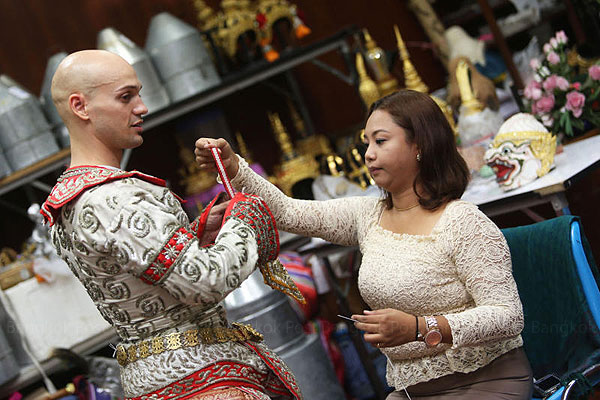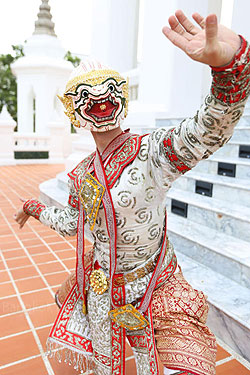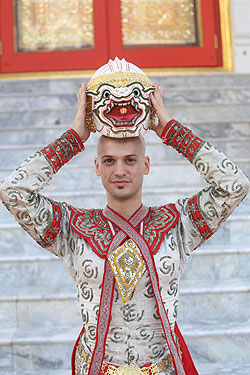
By Ajarn Helen Jandamit
Photos courtesy of Bangkok Post
University Tips is here to help you prepare for the English exams and tests that are coming your way. It gives you practise answering questions similar to those you may have at school and also on the University Entrance Examination.
Read the following story by Pichaya Svasti from the Bangkok Post. Then, answer the questions that follow.

Three men wearing white shirts and red jongkraben (traditional Thai trousers) are practising khon dance in a classroom. From a distance, they look like Thai masked dance experts. However, one of them is a 30-year-old Canadian named Benjamin Tardif.
Benjamin is studying at Bunditpatanasilpa Institute for a master’s degree in the teaching of Thai performing arts. His passion for traditional Thai dance began when, as part of a cultural exchange programme in 2002, he studied at Sukhothai Witthayakhom School in Sukhothai.
“When I watched khon for the first time, I was amazed because I had never seen such a performance before, but I didn’t understand what it was,” Benjamin recalled.
As part of his studies, Benjamin was sent to Sukhothai Performing Arts College to learn different Thai arts, ranging from playing the wooden xylophone to Thai boxing, but it was khon that fascinated him. He decided to learn more about it and asked Somchai Yimyaem, an instructor at that college, for permission to do that.
Khon is often based on tales from the Ramakien epic. In it, there are phra (male protagonists), nang (female protagonists), yak (giants or evil antagonists) and ling (monkey soldier assistants to phra) characters. Benjamin was given the role of a monkey due to his small frame and cheeky personality.
When he was in Sukhothai, although Benjamin was in grade 12, he studied khon with grade 7 students and practised more than 100 major dancing postures over a six-month period.
After returning to Canada, Benjamin studied to be a social science and history teacher. Ten years later, in 2012, he returned to Thailand on vacation and visited some of his old classmates in Sukhothai. He then decided to further his khon studies in Thailand.
Before he was allowed to enter the master’s degree programme at Bunditpatanasilpa Institute, Benjamin had to audition as well as pass a written test on the history and traditions of Thai performing arts. The judges said that although his dances were not perfect, his strong will and passion were evident and so gave him the green light.
Benjamin has been studying at the institute for one-and-a-half years. He spends most of his leisure time taking khon classes with the institute’s undergraduate students on weekdays, free classes at Thammasat University’s Khon Club on Monday and Wednesday evenings, and another class at Kukrit Institute on Sundays.
At Bunditpatanasilpa Institute, Benjamin gets the opportunity to study khon with leading instructor Viroj Yoosawat. He is also coached by khon expert and National Artist Prasith Pinkaew at Kukrit Institute.

Viroj is impressed with his student, who did not study the basics of khon in his childhood but can still dance along with the music.
“He is gifted, clever and able to catch up with more experienced students,” Viroj said. “At first, he was regarded as a black sheep, but not anymore.”
When Benjamin is not studying, he often performs khon at Chalerm Krung Theatre and is usually given the roles of Nilanon and Ongkhot, who are among Phra Ram’s monkey soldiers.
“I find khon difficult to perform because we must express our feelings while wearing masks, so we must show the gestures clearly,” Benjamin said.
As a foreigner, Benjamin says that he is very careful not to attempt to modify or misinterpret khon. After graduation, he plans to remain in Thailand and hopes to become a teaching assistant to teach khon to foreigners.
Exercises
Section 1

Read through the story. Then, answer the following multiple choice questions.
1. What is khon usually based on?
a. Tales from the Ramakien epic.
b. A master’s degree in the teaching of Thai performing arts.
c. The Phra, nang, yak and ling characters.
2. Where does Benjamin Tardif come from?
a. Sweden.
b. England.
c. Canada.
3. Why did Benjamin come to Thailand in 2002?
a. He came on vacation.
b. He came as an exchange student.
c. He came to study to learn about Thai boxing.
4. How long has Benjamin been studying at Bunditpatanasilpa Institute?
a. For one-and-a-half years.
b. For six months.
c. Since 2012.
5. Where does Benjamin perform khon?
a. At the Bunditpatanasilpa Institute.
b. At the Chalerm Krung Theatre.
c. At Sukhothai Witthayakhom school.
6. Who does Benjamin study khon with at the Bunditpatanasilpa Institute?
a. Prasith Pinkaew.
b. Somchai Yimyaem.
c. Viroj Yoosawat.
7. Where did Benjamin learn how to play the wooden xylophone?
a. At the Bunditpatanasilpa Institute.
b. At Sukhothai Performing Arts College.
c. At Sukhothai Witthayakhom school.
8. Who are Nilanon and Ongkhot?
a. They are two of Phra Ram’s monkey soldiers.
b. They are students at Sukhothai Witthayakhom School.
c. They are Thai masked dance experts.
Section 2
Read the story and decide whether the following statements are true or false.
9. Benjamin Tardif is a 30-year-old Canadian.
…………………
10. Benjamin was fascinated by Thai boxing when he was a cultural exchange student.
…………………
11. Benjamin did not study the basics of khon in his childhood.
…………………
12. Prasith Pinkaew is a khon expert and National Artist at the Kukrit Institute.
…………………
13. Benjamin is studying for a master’s degree at Bunditpatanasilpa Institute.
…………………
Section 3
Fill in the blanks in the following passage with grammatically correct words from the choices given.
Many Asian countries, including Myanmar, India, Cambodia, Laos and Malaysia, …..14….. performances based on Ramakien, …..15….. the costumes and dancing postures vary. …..16…..watching a Ramakien play in Cambodia, you…..17….. monkey characters that look very …..18…... . Unlike the Cambodian shows, Thailand’s performances focus more …..19….. beautiful dancing postures, .....20….. to Benjamin.

14.
a. has
b. having
c. have
15.
a. or
b. even
c. but
16.
a. After
b. While
c. Before
17.
a. will be seen
b. will see
c. will be
18.
a. natural
b. nature
c. naturally
19.
a. over
b. into
c. on
20.
a. account
b. accord
c. according
Section 4
Read the following sentences and underline the grammatically correct words from the choices given.
21. Benjamin studied khon with celebrated/celebrating/celebration instructor Viroj Yoosawat.
22. Benjamin did not study/studying/studied the basics of khon in his childhood.
23. Benjamin usual/usually/unusual performs khon at Chalerm Krung Theatre.
24. Dancers must express feelings while performance/performed/performing khon.
Vocabulary
- calling (n): a strong desire or feeling of duty to do a particular job or activity
xylophone (n): a musical instrument made of two rows of wooden bars of different lengths that you hit with two small sticks
protagonist (n): the main character in a story, play, film or book
antagonists (n): a person who strong opposes somebody or something
cheeky (adj): rude in an amusing or annoying way
will (n): a feeling of strong determination to do something
green light (n): permission for a project, etc. to start or continue
black sheep (n): a person who is different from the rest of their family or another group
misinterpret (v): to understand something wrongly


